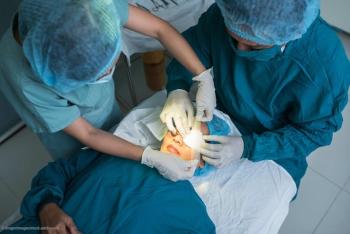
A disposable device for automated anterior capsulotomy that uses precision pulse technology (Zepto, Mynosys Cellular Devices) demonstrated excellent performance in a series of 38 eyes.

A disposable device for automated anterior capsulotomy that uses precision pulse technology (Zepto, Mynosys Cellular Devices) demonstrated excellent performance in a series of 38 eyes.

Wisconsin ophthalmologist Gerald P. Clarke, MD, has developed a new horseshoe-shaped dilator for use during cases of intraoperative floppy iris syndrome.

A new silicone phacoemulsification sleeve (Ridged Sleeve, ASICO) designed with a variety of novel features is enabling safe and efficient microcoaxial cataract surgery, said Takayuki Akahoshi, MD.

Cataract surgery in eyes undergoing simultaneous endothelial keratoplasty requires several modifications in techniques.

Preloaded IOL systems can save almost 30 seconds of operating time in cataract surgery, according to Damien Goldberg, MD, who participated in a trial with a preloaded delivery system (AcrySof IQ IOL Model AU00TO with UltraSert, Alcon Laboratories).

Los Angeles ophthalmologist Mitchell Shultz, MD, shares some of his clinical experience with a next-generation phacoemulsification platform (Stellaris Elite, Bausch + Lomb). The new platform received 510(k) clearance from the FDA in April.

As the most common procedure performed by the ophthalmic surgeon, in 2014, 4.3 million cataract operations took place in the European Union Member States. It is estimated that more than 23 million procedures will be performed worldwide in 2016.

Implantation of a sulcus-supported, pseudophakic supplementary intraocular lens (IOL) can be a safe and effective method for improving vision in eyes with residual refractive error after cataract extraction, refractive lens exchange, or keratoplasty, said Thomas Kohnen, MD, PhD. It also can be used to provide reversible presbyopia correction.

The most common complication associated with the explantation of foldable intraocular lenses (IOLs) is lens dislocation or decentration. While glare and visual aberrations are the most common reasons for explanting multifocal lenses.

Staging patients based on their ocular pathologies using the most advanced diagnostic tools can result in excellent image quality by precisely establishing the need for lens- or corneal-based procedures.

Posterior chamber phakic IOLs can correct refractive errors associated with keratoconus and can also be combined with other surgical techniques when necessary, according to researchers.

Cataract surgery in patients with coexisting uveitis is more challenging than managing either condition alone. Surgeons must answer a different set of questions and consider alternative management strategies, said Debra A. Goldstein, MD, FRSC, professor of ophthalmology and director of the Uveitis Service, Department of Ophthalmology, Northwestern University Feinberg School of Medicine, Chicago.

There are a number of ways to improve near vision for presbyopes, including multifocal intraocular lenses (IOLs)–traditional or low add–and pseudoaccommodative IOLs. It has been well documented that a small pupil and higher order aberrations, such as spherical aberration (SA) or coma, can increase depth of focus.

Increased procedure volume and patient expectations have made IOL exchange procedures more common. Smaller incisions and the need to reduce trauma require new micro-instrumentation for best outcomes.

Though further study is needed to determine conclusively whether or not femtosecond laser-assisted cataract surgery (FLACS) is associated with better refractive outcomes compared with conventional manual surgery, FLACS offers many other benefits that justify its use, according to Robert J. Cionni, MD.

Femtosecond laser-assisted cataract surgery (FLACS) offers some advantages compared with a conventional manual procedure, particularly for certain patients. Currently, however, FLACS does not result in superior outcomes and it has drawbacks that outweigh its benefits, according to Rosa Braga-Mele, MD.

The 2017 meeting of the American Society of Cataract and Refractive Surgery (ASCRS) will be held May 5 to 9 at the Los Angeles Convention Center, but at least one guest speaker will be sharing his “out-of-this-world” experiences.

Femtosecond laser-assisted cataract surgery (FLACS) facilitated a precise capsulotomy and reduced phaco energy in a recent ongoing study with about 100 consecutive eyes, said Jeffrey Whitman, MD, Key-Whitman Eye Center, Dallas.

Pre-treatment with the femtosecond laser in eyes undergoing cataract surgery can induce miosis. The use of a pupil expansion device, however, offers an effective method for managing small pupils in femtosecond laser-assisted cases whether the problem pre-exists or is caused by the laser, said Boris Malyugin, MD, PhD.

A third system upgrade for a femtosecond laser system for refractive cataract surgery (Streamline III, LENSAR) will enhance the efficiency of the procedure, according to Jonathan Solomon, MD.

Retinal issues can impact cataract surgery outcomes, especially for those with multifocal or other premium lenses. While multifocal lenses may allow the patient to see more clearly across a range of distances, they may also decrease the amount of light that reaches the retina, exacerbating any issues that may already be present.

White light is comprised of different wavelengths of visible light, ranging from red (700 nm) to violet (400 nm). As white light passes through an optical system, each of its component wavelengths bends independently.

Achieving satisfaction for patients interested in a multifocal IOL begins with comprehensive preoperative screening and evaluation.

Using dysfunctional lens syndrome stages, physicians can discuss a range of treatment options with patients, based on clinical findings and refractive error.

Ophthalmologists must be prepared to perform corneal refractive surgery enhancements after cataract surgery-and LASIK is often the optimal choice, according to Robert K. Maloney, MD.